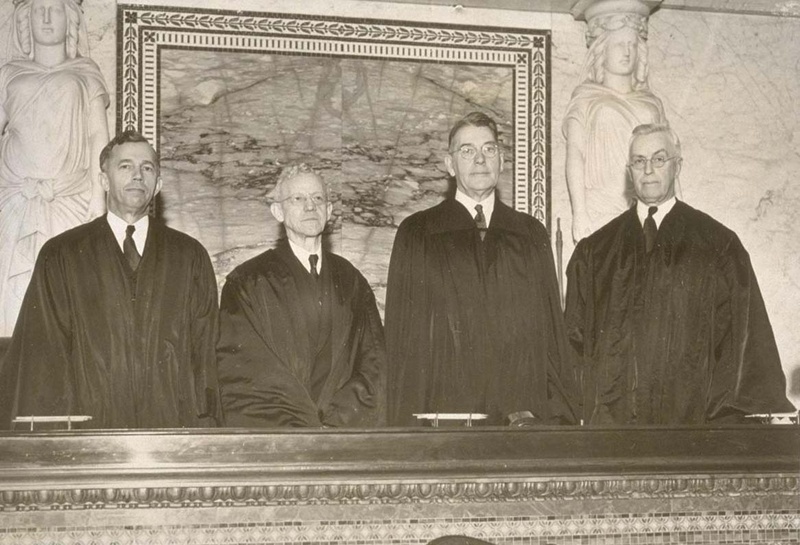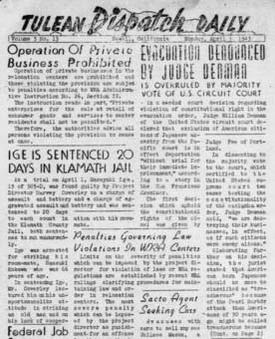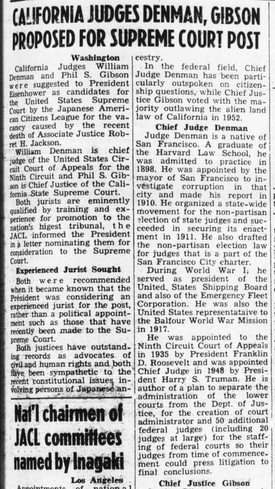Throughout the war years, Denman would cross swords with DeWitt and the Western Defense Command in the test cases against the wartime exclusion of Japanese Americans. The first major case to approach the bench of the 9th Circuit, however, was the lawsuit Regan vs. King. Spearheaded by the Native Sons of the Golden West, who were represented by former California attorney general and noted anti-Asian activist Ulysses S. Webb, the lawsuit’s goal was to prevent Nisei voters held in camp from voting in the August 1942 California primaries. More broadly, the plaintiffs wanted to use the case to overturn the landmark 1898 case Wong Kim Ark vs. United States, which legitimized birthright citizenship, and denaturalize all Americans of Japanese ancestry. On February 19, 1943, Webb presented his argument to the judges of the 9th Circuit. Immediately after Webb concluded, Denman and the other judges of the 9th Circuit conferred, and then threw the case out of court without even hearing the defense.
On the same day (coincidentally the first anniversary of the issuing of Executive Order 9066), Denman and his fellow judges heard a series of test cases against the Army orders targeting Japanese Americans. The first case, Hirabayashi vs. United States, was grouped with Yasui vs. U.S. as part of the challenges against the government curfew and registration requirements. Edward Ennis, the head of the alien enemy control unit, sought to have the curfew cases ruled by the Supreme Court in favor of the government. In the end, the 9th Circuit agreed to delay ruling on the case and passed it on to the Supreme Court.
Denman, however, objected to the actions of his fellow judges. According to Roger Daniels, Denman believed that the judges of the 9th Circuit, as West Coast residents, were the most qualified to make a decision, and he argued that the 9th Circuit failed to perform their duty of reviewing the cases. On March 28, 1943, Denman issued a dissent in the case of Hirabayashi vs. United States. In his eight-page opinion, Denman argued that the Army’s argument, based on “present danger of immediate evil,” failed to establish that the removal and suffering of thousands of U.S. citizens was a matter of military necessity. In his conclusion, however, Denman agreed that the case should be submitted to the Supreme Court for a final decision.
The second test case that the judges heard that day was Korematsu vs. United States, which concerned the mass removal of Japanese Americans. After delays over technical questions, the judges of the 9th Circuit Court finally handed down their decision in Korematsu on December 2nd, 1943, upholding the mass removal of Japanese Americans. Judge Curtis Wilbur’s majority opinion, which was signed by four other judges, asserted that the Supreme Court’s May 1943 ruling in Hirabayashi vs. United States served as a precedent in recognizing the special powers granted to the military during wartime, and that the legality of removal did not require “further elaboration.”
While Judge Denman did not dissent from the ruling, he did not join the Chief Judge’s opinion. Instead, he authored a concurrence that included a scathing indictment of the incarceration and its repercussions for American ideals. In it, Denman compared the treatment of Japanese Americans to that of Jews in Nazi Germany:
“Along with him are 70,000 American citizens men, women and children who, under similar orders, have been torn from their homes, farms and places of business to be imprisoned together in large groups, first in barbed wire stockades called Assembly Centers, then, after deportation, in distant places under military guard. As Justice Murphy states in his concurring opinion in Hirabayashi v. United States…their treatment is not unlike that of Hitler (sic) in so confining the Jews in his stockades.”
Denman equally attacked the euphemistic language used by the government in the incarceration process, noting that terms like ‘evacuation’ and ‘relocation’ masked the realities of deportation and imprisonment that comprised the process. Denman concluded that, as a result of the incarceration, Congress should pass legislation to compensate Japanese Americans for their losses. Supreme Court Justice Frank Murphy would later echo these sentiments in his dissent to the Supreme Court’s ruling in Korematsu vs. United States in December 1944. Denman pointedly sent a copy of his opinion to First Lady Eleanor Roosevelt, hoping to encourage her in her support of Japanese Americans.
Various camp newspapers cited Denman’s words in his twin opinions. In response to the Hirabayashi case, the Tule Lake camp’s Tulean Dispatch printed the headline “Evacuation Denounced by Judge Denman” in its April 5th, 1943 issue. Other camp newspapers, such as the Rohwer Outpost and Minidoka Irrigator, printed similar headlines, using news copied from a report by the San Francisco Chronicle. In the Heart Mountain Sentinel’s March 11, 1944 issue, parts of Denman’s opinion on Korematsu vs. United States were reprinted. In the December 18, 1943 issue of the Pacific Citizen, an editorial noted Denman’s proposal for compensation to Japanese Americans.
Denman’s last action regarding the wartime cases came in April 1944. As Roger Daniels documents in his recent book The Japanese American Cases, Denman made a key intervention in the case of Endo vs. U.S. Sometime before April 14, 1944, Denman phoned Mitsuye Endo’s lawyer, James Purcell, to propose certifying his client’s case directly to the Supreme Court, in order to speed consideration of the case by the High Court. Delighted by the offer, Purcell immediately petitioned for the case to be taken by the Supreme Court. Within a matter of weeks, the Supreme Court accepted Endo’s case, which was heard at the same time as Fred Korematsu’s challenge to mass removal (Rulings in both cases were issued on December 18th, 1944, with Korematsu vs. U.S. infamously upholding the exclusion of Japanese Americans, and Endo vs. U.S. ending the ongoing exclusion and detainment of Japanese Americans).
Even after the end of World War II, Judge Denman continued to rule in favor of Japanese Americans in his opinions. In June 1946, the 9th Circuit Court upheld the conviction of a hundred draft evaders who had refused to register at Poston concentration camp. Although siding with the majority, Denman noted in his opinion his sympathy with the defendants, and argued that the convicts should receive executive clemency.
Several of Denman’s rulings affected the civil rights of other minority groups. In April 1947, Denman and his fellow judges on the 9th Circuit Court issued their ruling in Westminster vs. Mendez, striking down the Orange County School Board’s discriminatory policy of segregating Mexican American students from white students. In a concurrence, Denman went so far as to call for the indictment of the Orange County board members who had perpetrated the discriminatory policy. The victory in Mendez one of several anti-segregation initiatives backed by the NAACP and the Japanese American Citizens League, served as a forerunner of the Supreme Court’s landmark 1954 ruling in Brown vs. Board of Education. In October 1947, Denman likewise struck down Hawaii’s 1943 ban on foreign language schools in a case that targeted Chinese language schools.
In 1948, President Harry Truman appointed Denman Chief Judge of the 9th Circuit Court of Appeals. Shortly afterwards, in April 1949, the 9th Circuit heard the case of Miye Murakami v. Acheson. The plaintiffs were three Japanese American women, Miye Mae Murakami, Tsuako Sumi, and Mutsu Shimizu, who confined at Tule Lake and who had renounced their citizenship via the Renunciation Act of 1944. When they attempted to apply for U.S. passports in 1948, the State Department rejected their applications on the grounds that they were no longer U.S. citizens. ACLU attorney A.L. Wirin, who represented the three women, argued before the court that their renunciation occurred due to intimidation by fellow inmates at the Tule Lake Segregation Center, and could not be considered voluntary. The case served as a test case against the legitimacy of the wartime incarceration and the “repatriation” policy of sending Japanese Americans to Japan.
Denman ruled in favor of the plaintiffs, and in his decision seized the opportunity to eviscerate Executive Order 9066. Repeating his previous criticism from the wartime cases, Denman described the camps as “unnecessarily cruel and inhumane,” and the conditions there often worse than in Federal penitentiaries. Crucial to Denman’s ruling was the publication of several studies critical of the wartime incarceration and its detrimental effects on Japanese Americans. On several places in his opinion, Denman cited Dorothy Swaine Thomas and Richard Nishimoto’s study The Spoilage, which drew from anthropological studies of Tule Lake and government records to paint a vivid picture of the chaos at Tule Lake.
Murakami vs. Acheson did not resolve the question of how the 4000 other Japanese American renunciants should be treated. The answer would appear in the subsequent ruling of McGrath vs. Abo in 1951. Tadayasu Abo, represented by Wayne Collins (Collins was also a close friend of Denman), was one of several Tule Lake renunciants who had signed his renunciation forms under duress. Collins argued that the psychological state of Abo and 4300 other renunciants was compromised by the harsh conditions at Tule Lake camp, and that the renunciation orders of all former Tule Lake internees should be annulled. In contrast to Murakami vs. Acheson, where Wirin cited intimidation by pro-Japan pressure groups such as the Hoshi Dan as the cause of mass renunciations at Tule Lake, Collins argued that the government needed to accept responsibility for creating a hostile environment. In their final ruling, Denman and the 9th Circuit sided with Abo, but did not grant a broad annulment of all renunciations. However, Denman concurred with Collins that the burden of proving the legitimacy of the renunciations lay with the government instead of with individual renunciants. Although Denman did not waive the renunciations of all 4300 individuals, he reaffirmed the citizenship of all those who were below the age of 21 at the time. In total, thanks to Collins’s efforts and the decision of Denman and the 9th circuit, over 2000 renunciants regained their citizenship. Collins spent the next twenty-three years trying to help the remaining 2300 renunciants regain their citizenship.
Denman’s defense of civil rights did not go unnoticed by Japanese Americans. The Pacific Citizen immediately applauded the court’s decision in Abo and foresaw its potential for future litigation against the incarceration policy. In October 1954, the Japanese American Citizens League submitted a resolution to President Eisenhower suggesting that Denman be nominated to the Supreme Court.
On June 26, 1957, Chief Judge William Denman retired formally from the bench. Sadly, his retirement was brief. Denman fell into a state of depression after his wife’s death, and on March 9, 1959 he took his own life. His obituary was printed in several major newspapers, including The New York Times and Los Angeles Times. Denman was also memorialized in the pages of the Rafu Shimpo, whose editors praised Denman’s vote to reinstate the citizenship of the Tule Lake renunciants.
As one of the few jurists to openly criticize the incarceration as it unfolded, Denman gave voice to the plight of Japanese Americans, in a way that was largely unique among wartime jurists. Alongside Eugene Rostow’s scathing 1945 article, “Our Worst Wartime Mistake,” Denman’s rulings helped promote the idea of compensating Japanese American incarcerees for the economic hardships they faced following their forced removal. Likewise, during the hearings of the Commission on Wartime Relocation and Interment of Civilians, several witnesses pointed to Denman’s rulings as evidence of the blatant racism of the incarceration and its damning effects on the American legal system. William Denman’s story serves as a reminder that, despite the overwhelming support of the incarceration among government officials, there were nonetheless people in power that spoke out against it.
*Author's note: Special thanks to Sharon Yamato for her help with this article.
© 2022 Jonathan van Harmelen









